How and Why to Use FeedBurner
One of the basic steps in setting up a blog that makes the most of the medium is getting an account with www.Feedburner.com. No matter what blogging platform you use to write your blog, there are good reasons why you should use Feedburner. Below are some reasons why, followed by some steps on how to use the service.
What is Feedburner?
The simplest answer to this question is that Feedburner republishes your RSS blog's RSS feed (or any RSS feed for that matter) to make it much friendlier, more powerful and more useful.
What am I going to get out of this?
- Find out how many people are subscribed to your RSS feed. These are the folks who are going to keep coming back to your content, more than any other group of visitors to your site. It's good to know how many of them there are and how that number has changed over time.
- Make it easier than ever for readers to subscribe to your feed. By email, MyYahoo, Bloglines, Newsgator and more are all options with at most two clicks of a lambs tail when you use Feedburner. And it's so much more friendly than a Movable Type or Wordpress "subscribe to this blog's feed" link with a whole bunch of XML behind it. Here - go click on my feed and see how pretty it is.
- You are going to set up Feedburner to automatically ping Technorati and everybody else who ought to know when you've posted something new on your blog so that it will show up in search engines.
- There are lots of extra features that are easy to select as add-ons to your feed. For example, people who subscribe to my feed see links after every item to email that post to some one, save it in del.icio.us, see how many comments on are on that post and make a comment themselves. You can also display inbound links to that item and lots more.
There are lots of other reasons you might want to use Feedburner.com, but those are my big ones and aren't they enough? Make it easy for people to subscribe to your blog's feed, for you to know how many people have subscribed, for search engines to know when you have something new for them to index and for your readers to do extra things they like to do with each item in your feed. I think these reasons alone make Feedburner.com an essential part of blogging.
How do I do it?
Ok, you're convinced, that's good. Grab your blog's native feed URL by copying the link to subscribe (if you write a blogger.com blog, it's myblogissilly.blogspot.com/atom.xml except of course your blog isn't silly).
Now paste that puppy into the front page of Feedburner. Setting up an account there is easy and it is free. After you tell the service just a wink about yourself (not very hard, this part) then you can bop around and optimize the features. My advice is to optimize in every way available that's free. And if you have some funds available, take these people up on their premium services because they are an institution of great public good and deserve it.
Make sure you turn on the Pingshot service under the Publicize tab. And unless you have a blog that only people interested in new web technology are reading (like this one, I believe) you should make sure to turn on the Email subscription option.
You will get a snippet of code for the email subscription option. That is to be copied and pasted into a good place on the sidebar of your blog's template. Then you can go to the Chicklet Chooser page and get the code for your RSS subscription option's link. I recommend selecting the standard icon, when readers click through it they will see all the other options on the pretty RSS feed page. If you want to see how this looks, you can go and click on my orange icon in my right hand sidebar here.
Grab that code for what Feedburner calls your chicklet (your new "subscribe" button) and paste that into your blog's sidebar template.
We're almost there, just a few more steps. If your blog software already had a link to your RSS feed in your sidebar, delete it. You don't want some people subscribing to the naked feed and some to the shiny new Feedburner.com feed or else you'll lose out on a lot of what you gain from the service.
Next, this is the hardest part. Go into your blog's template, go to the header section, and replace the code for the blog's native feed or feeds with your new Feedburner.com feed. This step may be a real challenge is you use a system that doesn't let you get to your template code easily. You can update it easily in the Blogspot blogs as you only have to go to the settings to change it.
Finally, I highly recommend making a post to your blog telling your readers that they can now subscribe to your blog's feed using your fancy new feed URL. This will spur some new subscriptions and let subscribers to the old feed know that they need to get with the program - so you can count them and they can see your souped up feed in their feed readers.
You can run as many feeds as you want in feedburner. You can even have more then 1 feeds for the same Blog.
Read More Add your Comment
How to Place Adsense on Your Blog
One of the most popular ways to make money blogging is through Google AdSense. It allows almost anyone with a blog or website to create an account and place ads. The ads are, for the most part, targeted to each blog. For instance, a blog about writing will have ads about writing. Each time a visitor clicks on one of the AdSense links, the blogger earns money. The amount of money depends on the ad; different keywords bring in different amounts. Google will send a check once you receive $100 in revenue. It's quite easy make money online this way.
Create a Blog
Your first step is to create an account with your blog platform of choice. If you use Wordpress you may only be able to use AdSense if you install special plugins. If you use Blogger, there's actually an AdSense option within the template design feature. Read up on the different types of platforms to find out which works best for your needs. Be sure to read all the FAQs, specifically those related to advertising.
Open an Account with AdSense
Your next step is to open an account with AdSense. Simply sign up and fill out all the necessary information. Once approved, you can place AdSense on your blog.
Place AdSense on Your Blog
Log into your Adsense account and click on the "Adsense Settings" tab. If you wish to place ads on your website, click on the "Adsense for Content" link. Once you reach the "Adsense for Content" page, you can choose the type of ad you would like for your blog. You can choose a text ad, which consists of links, an image ad with is a picture or graphic, or both.
Choose your ad type and click "continue." Next
The next screen takes you to design page. Here you can choose the ad's size, shape and color. After your make your choice and click continue you'll be directed to a screen that allows you to click and highlight the HTML to copy and paste the AdSense code to your blog. Most bloggers prefer to place the code in the sidebar, but choose a design that works best for your blog.
Blogger
If you use Blogger, you can either paste the code as directed above, or click on the "template" option and drag and drop the code as desired. Blogger even offers an option allowing you to "blend" the ads into the blog. Many prefer this step as they don't have to find the perfect color match.
Read More Add your Comment
Earn Money with Google AdSense
Google AdSense is a fast and easy way for website publishers of all sizes to display relevant Google ads on their website's content pages and earn money. Because the ads are related to what your visitors are looking for on your site — or matched to the characteristics and interests of the visitors your content attracts — you'll finally have a way to both monetize and enhance your content pages.
It's also a way for website publishers to provide Google web and site search to their visitors, and to earn money by displaying Google ads on the search results pages. Google AdSense is the program that can give you advertising revenue from each page on your website—with a minimal investment in time and no additional resources.
AdSense delivers relevant text and image ads that are precisely targeted to your site and your site content. And when you add a Google search box to your site, AdSense delivers relevant text ads that are targeted to the Google search results pages generated by your visitors’ search request.
You can join with adSense https://www.google.com/adsense/login/en_US/
Read More Add your Comment
10 Amazing Concept Mobiles
1. Nokia 888 Communicator
Nokia definitely has the most interesting concept phones. Nokia 888 Communicator is a striking futuristic concept phone. The phone, which uses liquid batteries, speech recognition, flexible touchscreen and touch-sensitive body cover,is designed by Tamer Nakisci and won the Nokia Design Award.

2. Nokia Aeon
Nokia Aeon was presented by Nokia on their website in the Research & Development section. What is so great about this phone is that it looks like it will actually go into production next February. Of course, its just a rumor, but still, makes us hope to actually see it someday in the GSM shop. All we know about it for now is that its a touchscreen phone and it looks fantastic.
3. Sky "Sleak in Slim"
"Sleek and Slim" from SKY is another concept based on touchscreen technology. The phone has a discretely glowing touchpad, hideaway keys and generally utterly-fashionable minimalist design.
4. Benq-Siemes "Snaked"
Benq designers thought of women too and presented Snaked. This is a "reptile" looking phone, creepy somehow, but still is very cool. The Snaked is a fashion phone for sport loving women, because it also has body monitoring sensors to help the ladies keep those fine shapes.
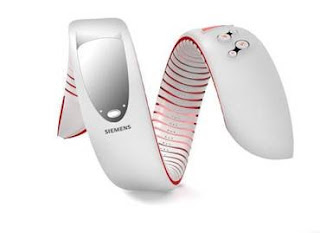
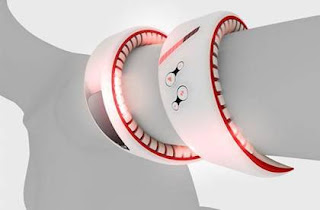
5. What You See is What You Get Concept
One thing is for sure about this concept phone they could've named it shorter. Designed by Pei-Hua Hang, the phone's name comes from the fact that this concept no longer uses an LCD as viewfinder for the digital camera, instead it uses a transparent frame. And of course, interaction is made through a touchscreen.
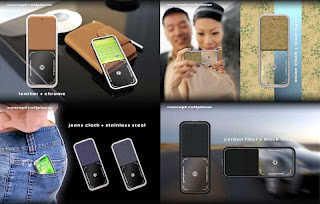
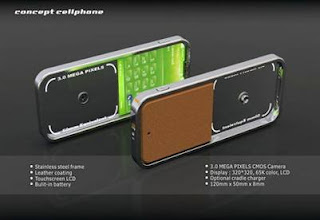
6. Retroxis By Dark Label
If most phones presented here will never be sold in store for sure, the Retroxis concept phone from Dark Label looks kinda human, and makes us hope we'll be able to get one of these one day. Designed by Lim Sze Tat the phone is encased in high polished polycarbonate renowned for its lightweight and toughness and has an invisible OLED display that silently hides away when inactive.
7. Benq-Siemens "The Blackbox"
Black Box designed by Benq-Siemens uses a touch screen as its keypad and, depending on the fun ctions you are using, the touch screen changes the control layout immediately.
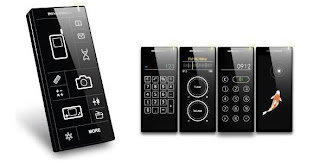
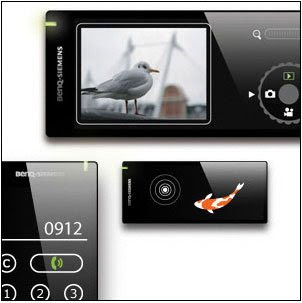
8 . NEC Tag
Somehow similar to the Snaked concept, the NEC Tag is a flexible phone concept that can be , for example, hung from a belt or wrapped around the user's arm. Interesting is that the phone has shape-memorizing material and sensors that allows the phone to change its shape according to the mode.


9. TripleWatch
Though the idea of a cellphone watch is not so new, the TripleWatch designed by Manon Maneenawa has an interesting triple flip technique that allows the user to transform the watch into a normal cellphone. When used as a wrist watch, the phone has a speaker button that allows the user to answer the phone and hang up while driving.

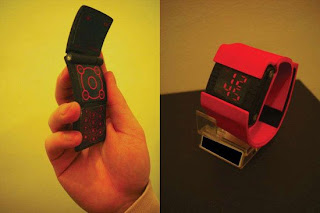
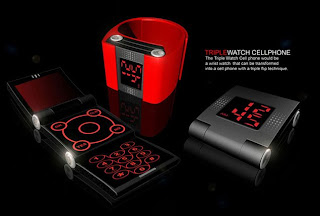
10. Asus Aura
Read More Add your Comment













